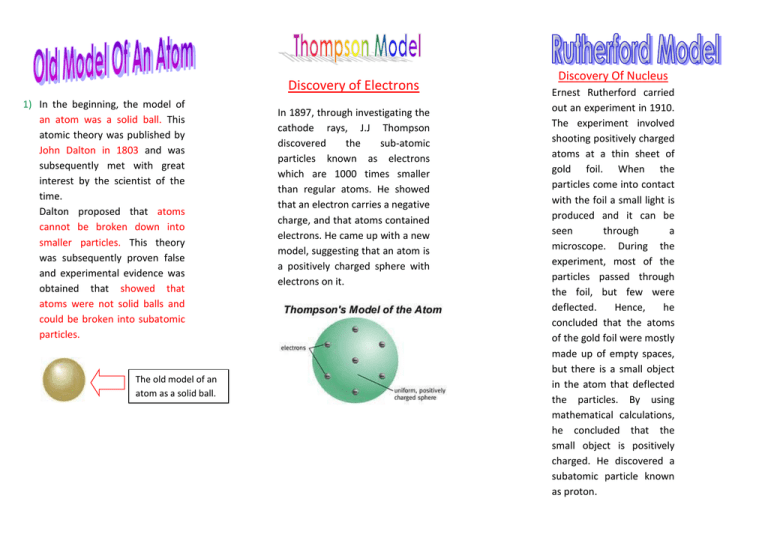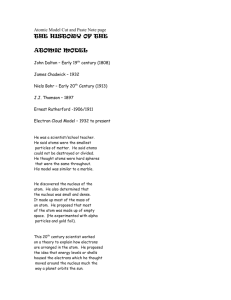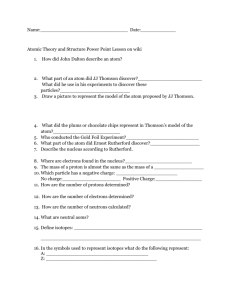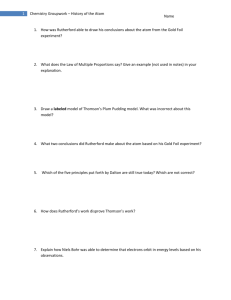Model of an Atom
advertisement

Discovery of Electrons 1) In the beginning, the model of an atom was a solid ball. This atomic theory was published by John Dalton in 1803 and was subsequently met with great interest by the scientist of the time. Dalton proposed that atoms cannot be broken down into smaller particles. This theory was subsequently proven false and experimental evidence was obtained that showed that atoms were not solid balls and could be broken into subatomic particles. The old model of an atom as a solid ball. In 1897, through investigating the cathode rays, J.J Thompson discovered the sub-atomic particles known as electrons which are 1000 times smaller than regular atoms. He showed that an electron carries a negative charge, and that atoms contained electrons. He came up with a new model, suggesting that an atom is a positively charged sphere with electrons on it. Discovery Of Nucleus Ernest Rutherford carried out an experiment in 1910. The experiment involved shooting positively charged atoms at a thin sheet of gold foil. When the particles come into contact with the foil a small light is produced and it can be seen through a microscope. During the experiment, most of the particles passed through the foil, but few were deflected. Hence, he concluded that the atoms of the gold foil were mostly made up of empty spaces, but there is a small object in the atom that deflected the particles. By using mathematical calculations, he concluded that the small object is positively charged. He discovered a subatomic particle known as proton. Bohr’s model of an atom Neil Bohr improved on the Rutherford Model which is now known as the Rutherford-Bohr Model. Bohr discovered that electrons orbit around the nucleus in shells. The shells are also known as ‘energy levels’. He also discovered that electrons can be moved to another shell if it is hit by an electron or a proton of light. If you look closely, u will be able to see that there is a ‘minus’ sign on the electrons. This means that the electrons are negatively charged. The Rutherford-Bohr’s model of an atom consists of the nucleus, electrons and shells. Differences between Dalton, Thompson, Rutherford and Bohr’s model If you are confused about who discovered what, do not worry as this is a small conclusion on Thompson, Rutherford and Bohr’s model. Chronologically, Dalton first discovered the atom and suggested that it is a simple solid ball. Then, Thompson proved that Dalton was wrong as he discovered that the atom also contained negatively charged subatomic particles known as electrons. Rutherford found out further that an atom does not consist of electrons only. He discovered that the atoms also contained a positively charged particle known as proton. Bohr then further improved Rutherford’s model and discovered that there were shells in which the electrons orbit around the proton. The atom structure that we are using now is not the Bohr’s model of an atom. but Rutherford-Bohr’s model of an atom. THE NEW MODEL OF AN ATOM The new model of an atom includes the three previously discovered subatomic particles. The proton, neutron and electron. The nucleus of the atom contains the protons and neutrons and the nucleus is surrounded by electrons which travel at nearly the speed of light. As the protons and neutrons are both heavier than the electrons, the nucleus is the densest part of the atom. Thus explaining why Rutherford observed that atoms would sometimes deflect of the foil. However, most of the atom is empty space thus explaining why most of the atoms Rutherford shot at the foil went straight through the foil. The new model of an atom with the nucleus and the electrons surrounding it.





